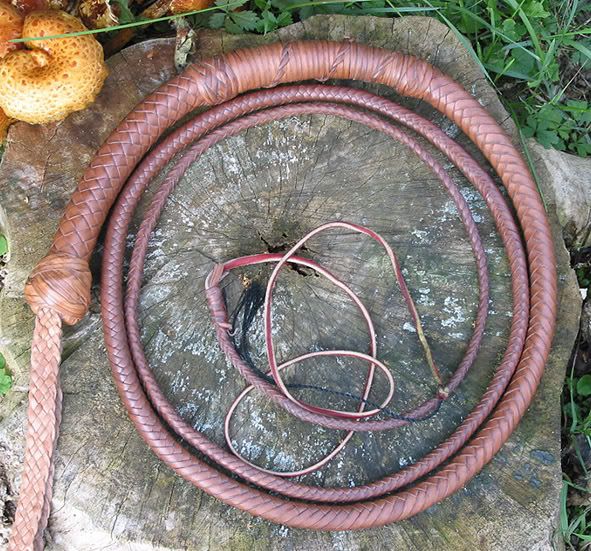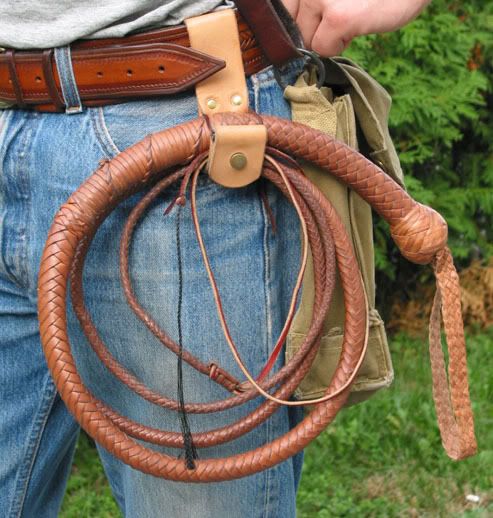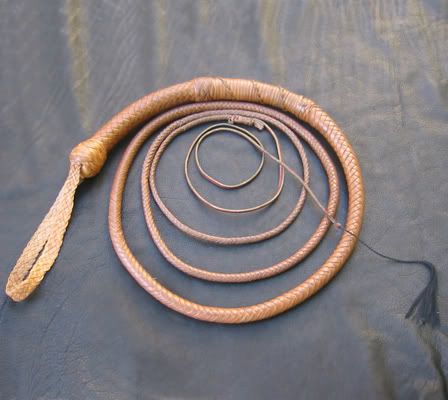Page 1 of 1
Nice 8ft snakewhip
Posted: Mon Oct 02, 2006 4:12 pm
by eaglecrow
After reading the post of Bernado about his visite to David Morgan I really felt for making another whip. Since I couldn't find a propper nail in my workshop I just decided to make another snakewhip. This time I decided to make it more heavy than the the last ones and also longer.
So here's the outcome: 8ft. 12 plait snakewhip with core, 2 bellies and bolsters:


This is the 7th. whip I made yet and I have to admit that I really love it. The extra handle decoration was made becouse the first 4 inches of the heringbone didn't looked good to me. So a good friend and whipmaker suggested me to do some decoration work on this arrea. So I made a french whipping as shown in Ron Edwards "whips and whipmaking" and it turned out really nice. This also makes a nice effect on the handling of the whip.
It cracks pretty easy, there is just one thing which bothers me a little: Although I braided the strands thight as ####, the last 2 feet are seem to be too flexible. It doesn't harm the whip since it still cracks very fine. In fact, it seem to be "pre broken-in"


Anyway, I hope you like it
Posted: Mon Oct 02, 2006 4:54 pm
by Mola Ram
nice

Is it loaded?
Posted: Mon Oct 02, 2006 5:24 pm
by eaglecrow
yep
snake whip
Posted: Mon Oct 02, 2006 5:59 pm
by Boggstandard
Now there is a great looking whip!!!
It looks very stout and heavy (which I like), and I love the french braid idea; not only as a design feature, but also to give the whip hand a little more purchase.
Just curious, but what is the whip's weight, and what is the handle circumference?
Congratulations!!!
When you are ready to make one to sell, let me know.
Best wishes,
Boggs
Posted: Tue Oct 03, 2006 11:30 am
by whiskyman
That's the coolest snake whip I've seen!

Posted: Tue Oct 03, 2006 11:35 am
by eaglecrow
Hello boggs,
I didn't knew that you're on cow, too! Nice to see you here. Thank you very much for your compliment, I appriciate that. Yes, the whip is pretty heavy. I will write the details of it later tonight or even tomorrow.
I havn't decided how much I will ask for such a whip, but I will let you know soon.
Posted: Tue Oct 03, 2006 4:15 pm
by winrichwhips
Yup, I like the looks of that whip, too. Very cool.
In Edwards' book I think he writes that the extra french grapevine lashing is meant to be used as a hand grip when turning the whip around and using it as a blackjack.
With your plaiting for the last 2 ft, how tight the plaiting ends up also depends on how wide your strands are in relation to the core. If you have wide strands and a small core, the plaiting will end up loose no matter how tight you pull. The trick is to experiment with the width of the strands, as well as the number of strands, in relation to the core to figure out how to get the tightness you want.
Also, I find if I drop strands early, the plaiting right after the strand drop ends up tighter, and if I drop strands late, the plaiting before the strand drop is looser.
One last thought, I would guess that the plaiting up to the last two feet is supported by a plaited belly. With kangaroo, the plaiting over the bellies tends to have a firmer feel to it since the bellies provide a solid, tight core.
-Adam
www.winrichwhips.com
-Adam
Posted: Wed Oct 04, 2006 9:41 am
by eaglecrow
So, I mesured the whip again. The handle does have a circumference of 3 1/4" and weight 1.6 lbs (0,8kg)
Yes, the french whipping is intended (as for snakewhips) like you sayed, but I'm happy to live in a city where crime is very low. But of course you can use it this way. But I guess for a 8ft snake it might be not very practical.
Although it is thought as a handle to move the whip into a tool for self protection, it is in fact good for the actuall whipcracking, since the whiplash have a longer arm to throw.
The plaiting on this one is such a thing: The last whips I made where of a slightly thinner leather and they where all nicley thight, and I did them more or less simmilar and with the same sort of plaiting soap

Posted: Thu Oct 05, 2006 4:47 am
by BullWhipBorton
BreinederIndy, Very nice. I like that one, especially the French grapevine patter you did on the thong. You know if you wouldn’t have said anything, I would not have guessed that is only your 7th whip. Nice evenly cut strands, smooth taper, tight looking plaiting, You need to keep making whips.
Dan
Posted: Thu Oct 05, 2006 5:29 am
by eaglecrow
Thank you Dan! I appriciate all your kind comments very much.
BullWhipBorton wrote:You know if you wouldn’t have said anything, I would not have guessed that is only your 7th whip.
I have to admit that Nick "pagey" Lang alway had good advices every time I started another whip. Since he allready made allmost 20 whips (and we started whipmaking togehter) he allready have some good knowledge. His experience and research work (and having a few hundred cups of tea together

) helped me a lot to have a good start
I can't tell yet if I will become a part time whipmaker in future but I will keep on braiding for sure.
Posted: Fri Oct 06, 2006 8:15 am
by eaglecrow
I just made a picture on black leather (as allways) of the whip. Didn't turned out as I want it to be. I'm planning to update my homepage soon, so which kind of whip picture do you prefer, wooden or black leather background?

Posted: Sat Oct 07, 2006 10:03 pm
by BullWhipBorton
You are welcome. It’s always a bonus if you can work with another whip maker who can give advice on what works and what doesn’t. Nick’s whips where starting to look really good too, I was sorry to hear he retired from whipmaking.
I liked the picture one on the wood better myself but mainly because its clearer. For some reason I always have trouble taking good pictures of black leather, whether it’s a whip or jacket or if I just want to use it as a background, maybe it absorbs too much light? In any case If you could adjust the focus either would look good. By the way nice website too, good looking products.
Dan
Posted: Mon Oct 09, 2006 2:39 am
by purewhips
That look really cool. I like both kinds of pics my self. On leather and wood. I go to my parents house sometime to take some pics of my whip, mom Has this really awesome dark table that I can take pics of. If not there the I take them on my light brown table. Laters.
Posted: Wed Oct 11, 2006 11:01 am
by mrrymen2
With your plaiting for the last 2 ft, how tight the plaiting ends up also depends on how wide your strands are in relation to the core. If you have wide strands and a small core, the plaiting will end up loose no matter how tight you pull. The trick is to experiment with the width of the strands, as well as the number of strands, in relation to the core to figure out how to get the tightness you want.
Also, I find if I drop strands early, the plaiting right after the strand drop ends up tighter, and if I drop strands late, the plaiting before the strand drop is looser.
I didn't expect to see this explanation of the relation between the tightness of the plaiting to the timing of the turndown discussed in this forum and my respect for Mr. Winrich has increased with his observation.
I have seen this turndown question debated recently on the Aust. Whipmaker site and in the magazine and I think only one whipmaker there had an idea of what the real issue really is.
A whipmaker whom I respect once told me that there are only two basic rules in making any good whip-- shape it right and plait it tight-- everything else is additional to these two fundamentals.
The turndowns in the whip are the whipmakers way of keeping to these rules. The strands are cut to a certain width judged by the whipmaker to take the tension he needs to get the tightness he wants but there is a width limit where he knows if he pulls to tightly, they will break.
There is a compromise between the width of the strands and the tightness . As the whip is plaited down over the core, and it must have a core or something or it won't flex right, the strings become too wide for the core and tend to bunch.This is called crowding where each strand rides a little on the previous strand and therefore cannot bight into the core and keep its tightness. This is where the maker needs to get rid of a couple of strands so they go into the core of the whip and the tightness is not compromised.
After some experience the whipmaker can predict when this is about to happen and turn down before so there is no loss of tension.
This is basic whipmaking but many have a deal of trouble getting a grip on it and it opens up more areas for discussion
all the best ...
littlejohn






